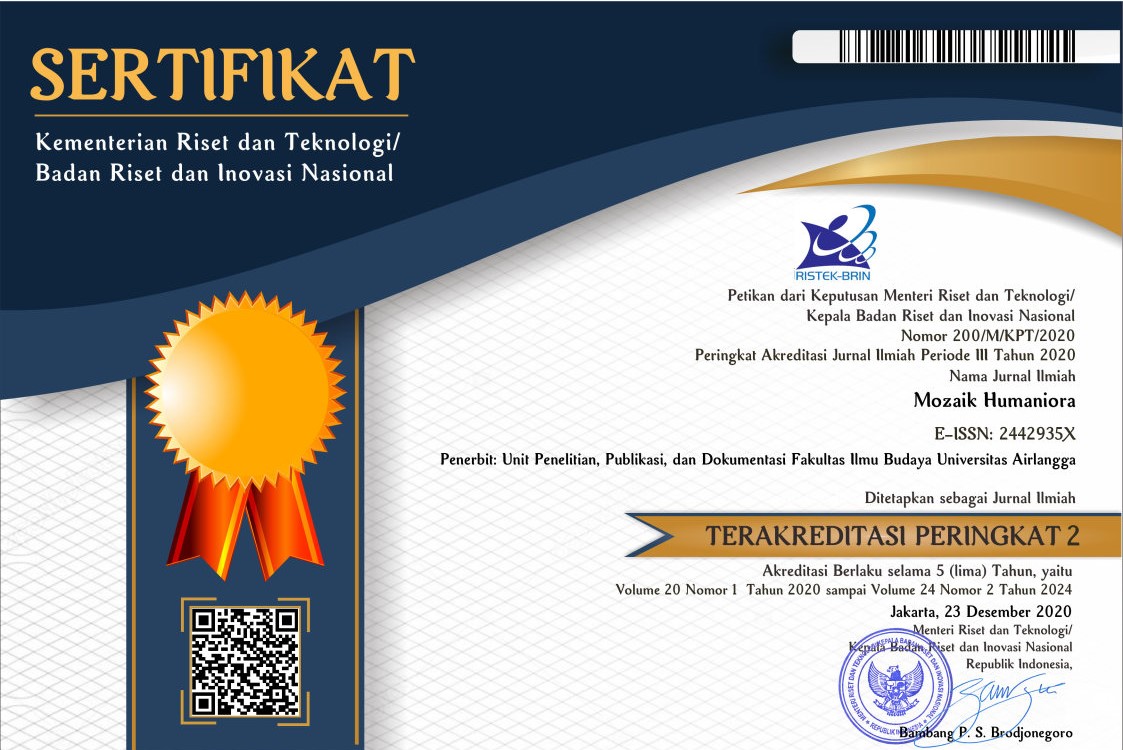Adaptation of Popular Names of Ornamental Plants in Indonesia
Downloads
This article explores the phenomenon of popular names for ornamental plants in Indonesia, emphasizing their role as both identifiers and representations of economic value. The popularity of these names is categorized based on their alignment (or lack thereof) with different parts of the ornamental plants. Employing a descriptive linguistic approach, the reference attributes of popular names are systematically grouped, followed by an image search and identification of their biological counterparts. The study also traces the elements contributing to the formation of names and their lexical meanings, incorporating both internal and external equivalents. Interviews with traders and collectors further support the meaning search, employing directional techniques and documenting substantive ethnographic patterns. A total of 85 names were collected from ornamental plant traders and collectors, supplemented by data from specialized YouTube channels. These popular names are further classified into nine categories based on plant attributes, such as structure (stalks, leaves, stems, and flowers), time, character, place, sound, and direction. The diversity in plant naming correlates with a complexity that extends beyond language, namely social class, selling price, and aesthetic considerations. Additionally, the naming process revolves around human preferences for convenience, practicality, and cultural phenomena. Changes in the naming of ornamental plants in Indonesia have substantial implications for shifting trends in people's preferences, as evidenced by the dimming landscape of post-pandemic YouTube channels and the ornamental plant market.
Andreastuti, Monika, Aziz Purwantoro, & Rudi Hari Murti. 2015. "Keragaman Molekuler Puring (Codiaeum Variegatum (L.) Rumph. Ex A. Juss) dengan Penanda RAPD.” Vegalitika 4 (2), 90”99.
Badan Litbang Pertanian, Balai Penelitian Tanaman Hias. 2021. "Laporan Kinerja Balai Penelitian Tanaman Hias 2020,” https://balithi-ppid.pertanian.go.id/doc/187/Laporan Kinerja/lakin-2020-balithi.pdf.
Bibit Bunga Group. 2022. "Aglaonema Widuri,” bibitonline.com/produk/aglaonema-widuri.
Botany Land. 2022. "Aglaonema Legacy,” mybotanyland.com/product/bibit-tanaman-aglaonema-legacy.
Elfianis, Rita. 2020. "Klasifikasi dan Morfologi Tanaman Spider Plant.” Agrotek, May 24.
Harti, Tumi, Mangatur Sinaga, & Hermandra. 2021. "Naming of Plant and Animal Elements in Meranti Islands,” Sastranesia 9 (1), 112–21. DOI: 10.32682/sastranesia.v%vi%i.1809.
Imbang, Djeinnie, Leika Kalangi, & Olga Karamoy. 2020. "Ekspresi Linguistik Tanaman Jagung sebagai Kearifan Lokal Penutur Bahasa Tombulu.” Jurnal Kajian Linguistik 8 (1), 1–13. DOI: 10.35796/kaling.8.1.2020.29101.
Kridalaksana, Harimurti. 2008. Kamus Linguistik. Jakarta: Gramedia Pustaka Utama.
Liunokas, Angreni Beaktris & Agsen Hosanty S. Billik. 2021. Karakteristik Morfologi Tumbuhan. Yogyakarta: Deepublish.
Mollick, Abdus Subhan, Hisashi Shimoji, Tetsuo Denda, Masatsugu Yokota, & Hideo Yamasaki. 2011. "Croton Codiaeum Variegatum (L.) Blume Cultivars Characterized by Leaf Phenotypic Parameters.” Scientia Horticulturae 132 (1), 71–79. DOI: 10.1016/j.scienta.2011.09.038.
Rosanti, Dewi. 2013. Morfologi Tumbuhan. Jakarta: Erlangga.
Santosa, Marisa Puteri Sekar Ayu. 2020. "Analisis Penamaan Kedai Kopi di Surabaya: Kajian Etnolinguistik.” Kredo: Jurnal Ilmiah Bahasa dan Sastra 3, no. 2: 386–99. DOI: 10.24176/kredo.v3i2.4788.
Santoso, Bambang B. 2010. "Pengantar Budidaya Tanaman Hias dan Bunga,” http://eprints.unram.ac.id/10970/1/Tanm-Hias-1-PENDAHULUAN%20%5BCompatibility%20Mode%5D.pdf.
Sinungharjo, F. X. 2020. "Leksikon Biotik di Panggung Musik: Perspektif Ekolinguistik.” Sintesis 14 (2), 109–30. DOI: 10.24071/sin.v14i2.2675.
Stibbe, Arran. 2015. Ecolinguistics: Language, Ecology and the Stories We Live By. DOI: 10.4324/9780367855512.
Suhandano. 2012. "Kategori Tumbuh-tumbuhan Wit dan Suket dalam Bahasa Jawa.” Humaniora 19 (1), 89–97. DOI: 10.22146/jh.895.
Sulistyorini, Ari. 2009. Biologi 1, disunting oleh Hadiat. Jakarta: Pusat Perbukuan Departemen Pendidikan Nasional.
Swarniti, N. W. & Ni Made Yuniari. 2019. "Keberadaan Leksikon Pohon Langka di Denpasar: Studi Ekolinguistik.” Dalam Seminar Nasional INOBALI 2019 Inovasi Baru dalam Penelitian Sains, Teknologi dan Humaniora, https://eproceeding.undwi.ac.id/index.php/inobali/article/view/180.
Wiraatmaja, I Wayan. 2016. "Teknologi Budidaya Tanaman Hias.” Denpasar: Fakultas Pertanian UNUD.
Yudono, Kristophorus Divinanto Adi. 2021. "Makna Nama Bunga dalam Konstruksi Nama Orang pada Masyarakat Kutoarjo-Jawa Tengah.” Jurnal Pendidikan Bahasa Indonesia 9 (1), 21–26. DOI: 10.30659/jpbi.9.1.21-26.
Copyright (c) 2023 Harum Munazharoh, Arum Rindu Sekar Kasih, Gulita Evapraja

This work is licensed under a Creative Commons Attribution-ShareAlike 4.0 International License.

Mozaik Humaniora is licensed under a Creative Commons Attribution-ShareAlike 4.0 International License. Both authors and Mozaik Humaniora agree with the following attribution of journal:
1. Copyright of this journal is possession of Author, by the knowledge of the Editorial Board and Journal Manager, while the moral right of the publication belongs to the author.
2. The journal allows the author(s) to retain publishing rights without restrictions
3. The legal formal aspect of journal publication accessibility refers to Creative Commons Attribution Share-Alike (CC BY-SA).
4. The Creative Commons Attribution Share-Alike (CC BY-SA) license allows re-distribution and re-use of a licensed work on the conditions that the creator is appropriately credited and that any derivative work is made available under "the same, similar or a compatible license”. Other than the conditions mentioned above, the editorial board is not responsible for copyright violation.


















